Contents
In recent years, progressive methods of cultivating strawberries in garden plots have greatly facilitated the work of gardeners and made it possible to obtain a maximum and stable yield. These include the cultivation of strawberries on agrofibre – a method that is rapidly gaining popularity among professionals and amateurs, due to its economy and high efficiency.
Advantages of growing on agrofibre
The biggest advantage of planting strawberries on agrofiber is a significant reduction in the time and effort to care for the beds. There is no need for exhausting constant weeding, loosening the soil, frequent watering during the hot period. On strawberry plantations under agrofibre, it is much easier to remove growing mustaches, since they do not grow with a carpet and do not take root. Such mulching material allows you to always pick clean berries and minimize damage to plants by gray rot. It will also save the site from pests such as slugs, a bear, a May beetle, a flower weevil, the fight against which can be protracted or permanent.
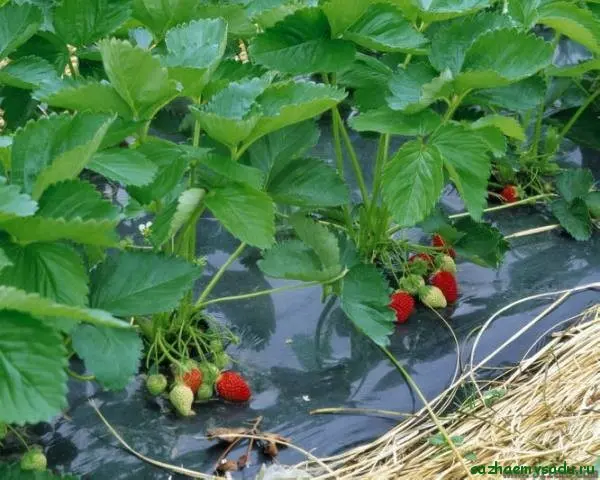
Under agrofibre for strawberries, moisture evaporates much more slowly, therefore, the plantation will have to be watered less often even in summer. Since it dries quickly, the berries also dry out and do not lie in the mud, which prevents them from rotting in a long, rainy summer. In addition, agrofibre allows you to reduce the ripening period of berries by more than 6-8 days. And strawberries planted in early spring under agrofibre take root better and faster and give a greater yield, in comparison with uncovered beds. Among other things, agrofibre is a very economical and practical material. You can easily buy it in garden shops or hypermarkets.
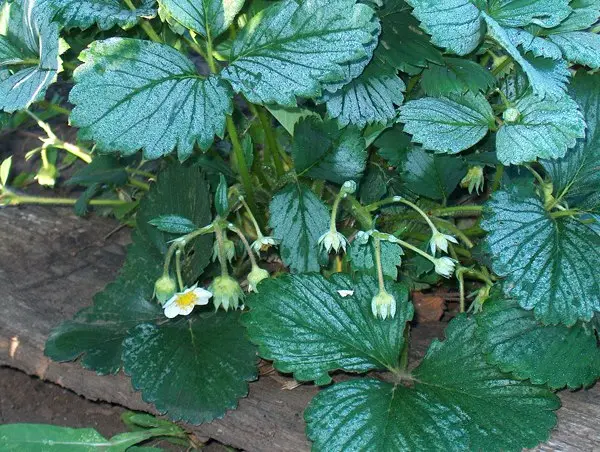
Material selection
As a ground cover material, a dark film, spunbond or agrofibre is most often used. But it is agrofibre for strawberries that suits better than others. It does not inhibit the plant during the heat period, when even with drip irrigation under other mulching material, the soil does not breathe, overheats, as a result of which the roots begin to rot and rot, the bushes get sick and die. It does not crack, turning into tatters in the fall; with proper care, it can last more than one season.
Agrofibre for strawberries comes in various densities. As a rule, it is preferable to buy material with a density of at least 60-70 g / sq m, since its service life is 3-4 years, just such a period the plantation will bear fruit well without transplanting. Depending on the planned width of the beds, a roll of material that is suitable in width is also selected. For strawberries, it is preferable to take dark agrofibre, rather than light, it retains moisture better.
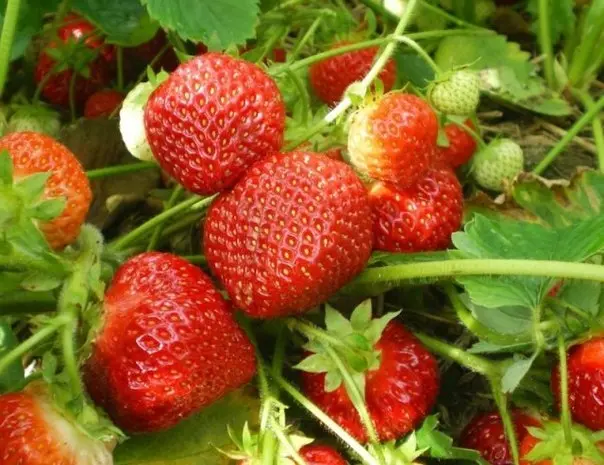
Arrangement of beds and paths
Often, strawberries under agrofibre are grown on high ridge beds, which are formed using a cultivator or special equipment. However, with relatively small planting volumes, it is more cost-effective to form beds on a flat surface. Since the covering material is cut into strips to cover the ridges, the remaining trimmings have nowhere to fit because of their size, that is, the material is not used practically. In the summer heat, the soil on the ramparts dries out faster, while in winter it freezes more strongly and faster. And when the time is right for replanting bushes, the vacated area for planting other crops will have to be carefully leveled.
Soil preparation
Before covering the soil with agrofibre for strawberries, additional work is carried out. In the selected area, the earth is deeply dug up, while removing the rhizomes of perennial weeds and other debris. Then at least 1-1,5 buckets of humus, 1,5-2 cups of wood ash, potash and nitrogen fertilizers, 150-180 g per sq. M. are added. After that, the site is re-digged up and leveled with a rake.

With the help of pegs, future beds are marked, leaving a distance between them of at least 1,1-1,25 m. Next, the leveled area is covered with agrofiber for strawberries, its edges are well fixed with wire hooks 22-26 cm long, construction plastic heels or pieces of paving slabs or flat stones. The fiber is laid in such a way that the strips overlap each other by at least 18-20 cm. On a well-stretched, pinned material, markings are made along the cords, marking the seedling planting sites with a rail.
Creating tracks
Tracks are necessary not only for convenient movement between beds, but also to increase the life of the fiber. According to the recommendations of the manufacturers, in order to avoid rapid wear, it is impossible to walk on it. To do this, use special covering paths, or fill the aisles with straw or sawdust. At the same time, sawdust retains moisture better and longer than straw. When wet, they become heavier and thereby additionally press the fiber to the ground, preventing it from rising from the wind. In addition, they can, if necessary, pin a mustache, which very quickly form roots in such conditions.
To calculate the approximate length of the path, you need to sit down between the bushes and stretch your arms forward. The distance from hands to feet, multiplied by two, is the most optimal between adjacent tracks. If joints are formed on the beds during laying, paths should definitely be laid in their place so as not to spoil the fiber.
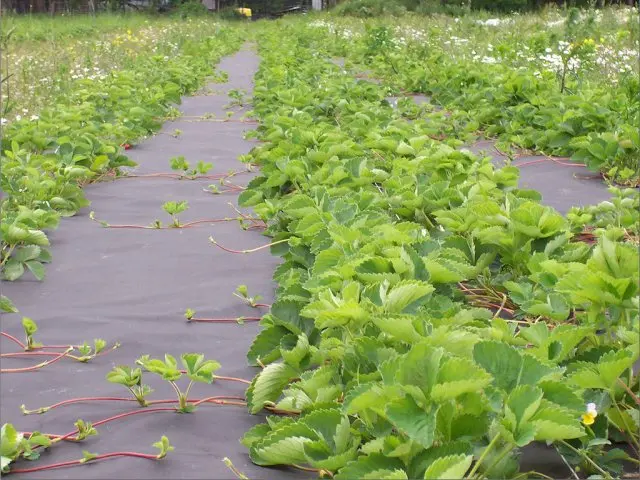
Landing
Planting strawberries on agrofibre is carried out using a two-line method, with a distance between rows of 60-65 cm, between rows – 45-50 cm, between bushes – 25-30 cm. This is the most optimal scheme for planting using fiber. A cross-shaped hole measuring 5 by 5 cm is made along the intended rail for each outlet, placing the corners outward.
If seedlings with closed roots in an earthen cup are used, then dig a deeper hole with a small scoop. If ordinary seedlings are planted, then the roots are cut to 7-9 cm, and the holes are no longer so deep. A bush is placed in the incised hole and the corners of the fiber are wrapped inward. The rosette of leaves should be at ground level. After full planting, the beds are watered abundantly. Repeated watering is carried out after 2-3 days, and then drip irrigation is used every 3-4 days in the evening.
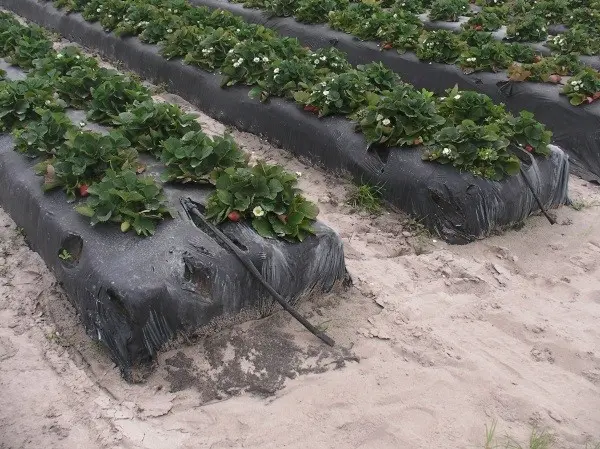
Care for strawberries
Caring for strawberries under agrofibre is practically no different from growing plants in open ground. Since the soil was well enriched before planting, the plantation is not fed in the first 1-2 years after planting. In the future, organic fertilizers in the form of mullein, chicken manure or humus and nitrogen-containing fertilizers are applied three times per season. The first top dressing is carried out before the beginning of the growing season in early spring, the second – before flowering, the third – after fruiting, when the flower buds of the crop for the next year are laid.
Watering is carried out in 5-6 days, since agrofibre delays the evaporation of moisture by 25-35%. Irrigate both with a hose and sprinklers, depending on the possibilities. In both cases, the fiber does not prevent the soil from being saturated with water.
Video “Planting and growing strawberries under agrofibre”
This video shows how the bushes are planted under the fiber.









